Dye Dale, O`neill Robert. The road to victory: From Pearl Harbor to Okinawa
Подождите немного. Документ загружается.

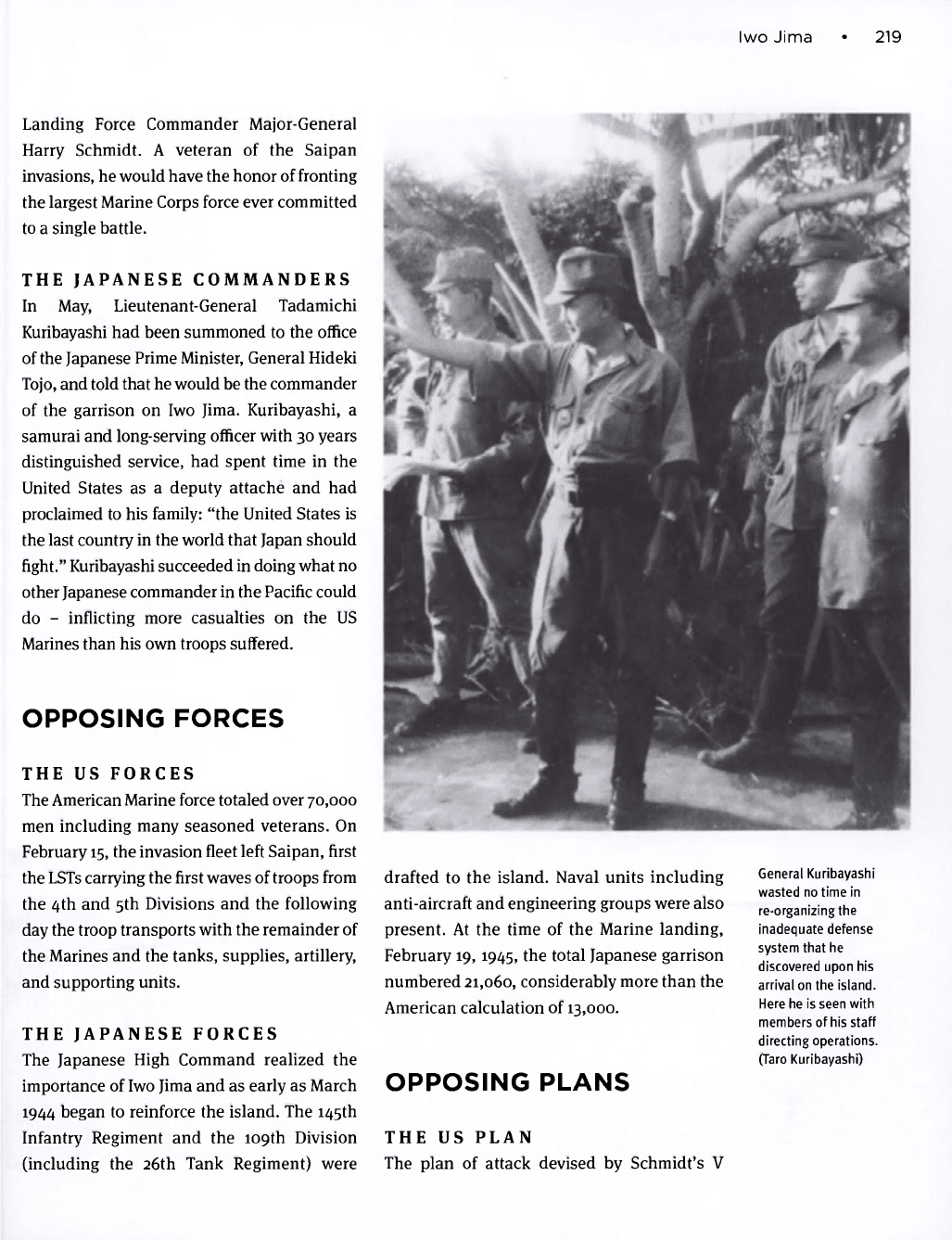
Iwo Jima • 219
Landing Force Commander Major-General
Harry Schmidt. A veteran of the Saipan
invasions, he would have the honor of fronting
the largest Marine Corps force ever committed
to a single battle.
THE JAPANESE COMMANDERS
In May, Lieutenant-General Tadamichi
Kuribayashi had been summoned to the office
of the Japanese Prime Minister, General Hideki
Tojo, and told that he would be the commander
of the garrison on Iwo Jima. Kuribayashi, a
samurai and long-serving officer with 30 years
distinguished service, had spent time in the
United States as a deputy attache and had
proclaimed to his family: "the United States is
the last country in the world that Japan should
fight." Kuribayashi succeeded in doing what no
other Japanese commander in the Pacific could
do - inflicting more casualties on the US
Marines than his own troops suffered.
OPPOSING FORCES
THE US FORCES
The American Marine force totaled over 70,000
men including many seasoned veterans. On
February 15, the invasion fleet left Saipan, first
the LSTs carrying the first waves of troops from
the 4th and 5th Divisions and the following
day the troop transports with the remainder of
the Marines and the tanks, supplies, artillery,
and supporting units.
THE JAPANESE FORCES
The Japanese High Command realized the
importance of Iwo Jima and as early as March
1944 began to reinforce the island. The 145th
Infantry Regiment and the 109th Division
(including the 26th Tank Regiment) were
drafted to the island. Naval units including
anti-aircraft and engineering groups were also
present. At the time of the Marine landing,
February 19,1945, the total Japanese garrison
numbered 21,060, considerably more than the
American calculation of 13,000.
OPPOSING PLANS
General Kuribayashi
wasted no time in
re-organizing the
inadequate defense
system that he
discovered upon his
arrival on the island.
Here he is seen with
members of his staff
directing operations.
CTaro Kuribayashi)
THE US PLAN
The plan of attack devised by Schmidt's V
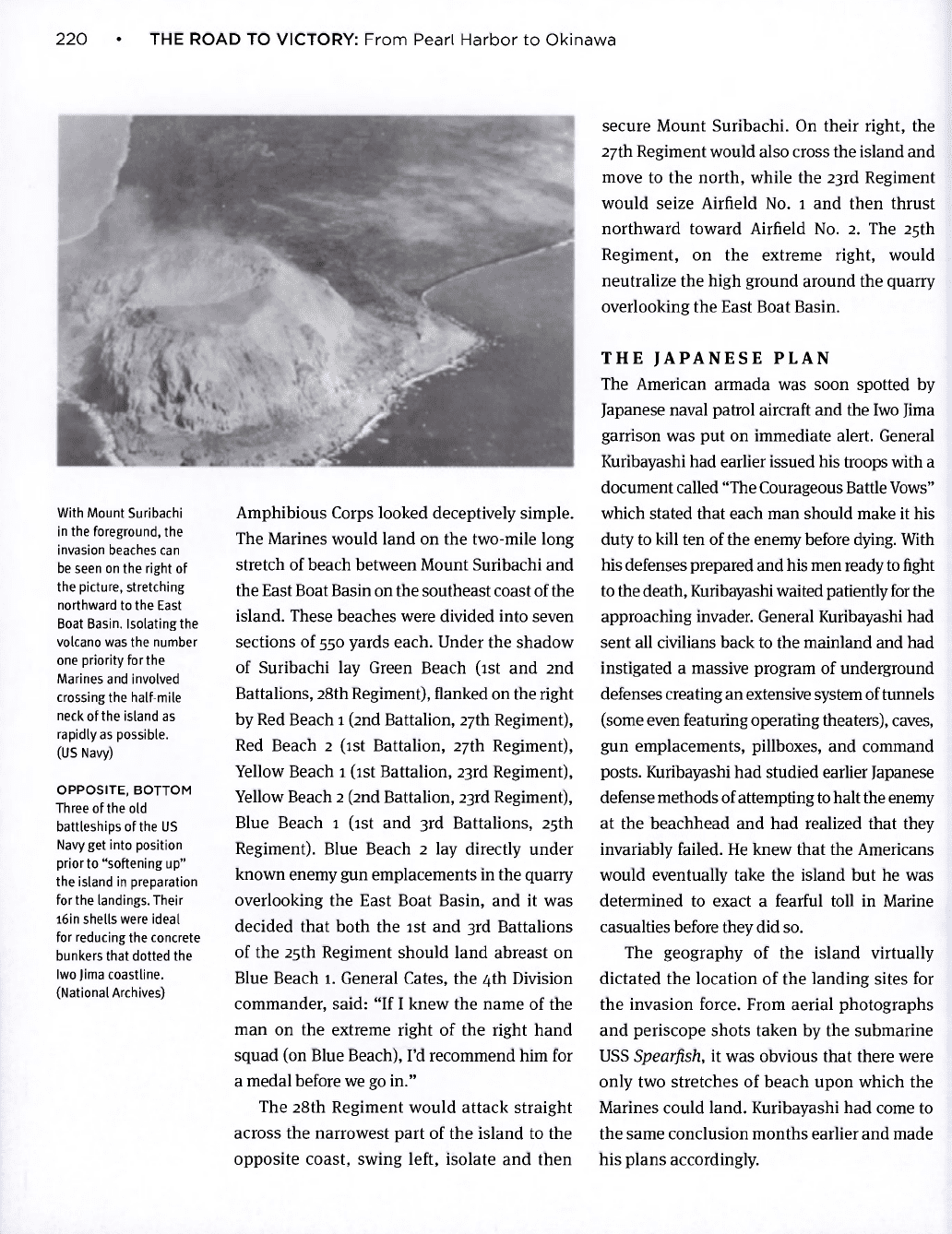
220 • THE ROAD TO VICTORY: From Pearl Harbor to Okinawa
With Mount Suribachi
in the foreground, the
invasion beaches can
be seen on the right of
the picture, stretching
northward to the East
Boat Basin. Isolating the
volcano was the number
one priority for the
Marines and involved
crossing the half-mile
neck of the island as
rapidly as possible.
(US Navy)
OPPOSITE, BOTTOM
Three of the old
battleships of the US
Navy get into position
prior to "softening up"
the island in preparation
for the landings. Their
i6in shells were ideal
for reducing the concrete
bunkers that dotted the
Iwo lima coastline.
(National Archives)
Amphibious Corps looked deceptively simple.
The Marines would land on the two-mile long
stretch of beach between Mount Suribachi and
the East Boat Basin on the southeast coast of the
island. These beaches were divided into seven
sections of 550 yards each. Under the shadow
of Suribachi lay Green Beach (1st and 2nd
Battalions, 28th Regiment), flanked on the right
by Red Beach 1 (2nd Battalion, 27th Regiment),
Red Beach 2 (1st Battalion, 27th Regiment),
Yellow Beach 1 (1st Battalion, 23rd Regiment),
Yellow Beach 2 (2nd Battalion, 23rd Regiment),
Blue Beach 1 (1st and 3rd Battalions, 25th
Regiment). Blue Beach 2 lay directly under
known enemy gun emplacements in the quarry
overlooking the East Boat Basin, and it was
decided that both the 1st and 3rd Battalions
of the 25th Regiment should land abreast on
Blue Beach 1. General Cates, the 4th Division
commander, said: "If I knew the name of the
man on the extreme right of the right hand
squad (on Blue Beach), I'd recommend him for
a medal before we go in."
The 28th Regiment would attack straight
across the narrowest part of the island to the
opposite coast, swing left, isolate and then
secure Mount Suribachi. On their right, the
27th Regiment would also cross the island and
move to the north, while the 23rd Regiment
would seize Airfield No. 1 and then thrust
northward toward Airfield No. 2. The 25th
Regiment, on the extreme right, would
neutralize the high ground around the quarry
overlooking the East Boat Basin.
THE JAPANESE PLAN
The American armada was soon spotted by
Japanese naval patrol aircraft and the Iwo Jima
garrison was put on immediate alert. General
Kuribayashi had earlier issued his troops with a
document called "The Courageous Battle Vows"
which stated that each man should make it his
duty to kill ten of the enemy before dying. With
his defenses prepared and his men ready
to
fight
to the death, Kuribayashi waited patiently for the
approaching invader. General Kuribayashi had
sent all civilians back to the mainland and had
instigated a massive program of underground
defenses creating an extensive system of tunnels
(some even featuring operating theaters), caves,
gun emplacements, pillboxes, and command
posts. Kuribayashi had studied earlier Japanese
defense methods of attempting to halt the enemy
at the beachhead and had realized that they
invariably failed. He knew that the Americans
would eventually take the island but he was
determined to exact a fearful toll in Marine
casualties before they did so.
The geography of the island virtually
dictated the location of the landing sites for
the invasion force. From aerial photographs
and periscope shots taken by the submarine
USS Spearfish, it was obvious that there were
only two stretches of beach upon which the
Marines could land. Kuribayashi had come to
the same conclusion months earlier and made
his plans accordingly.
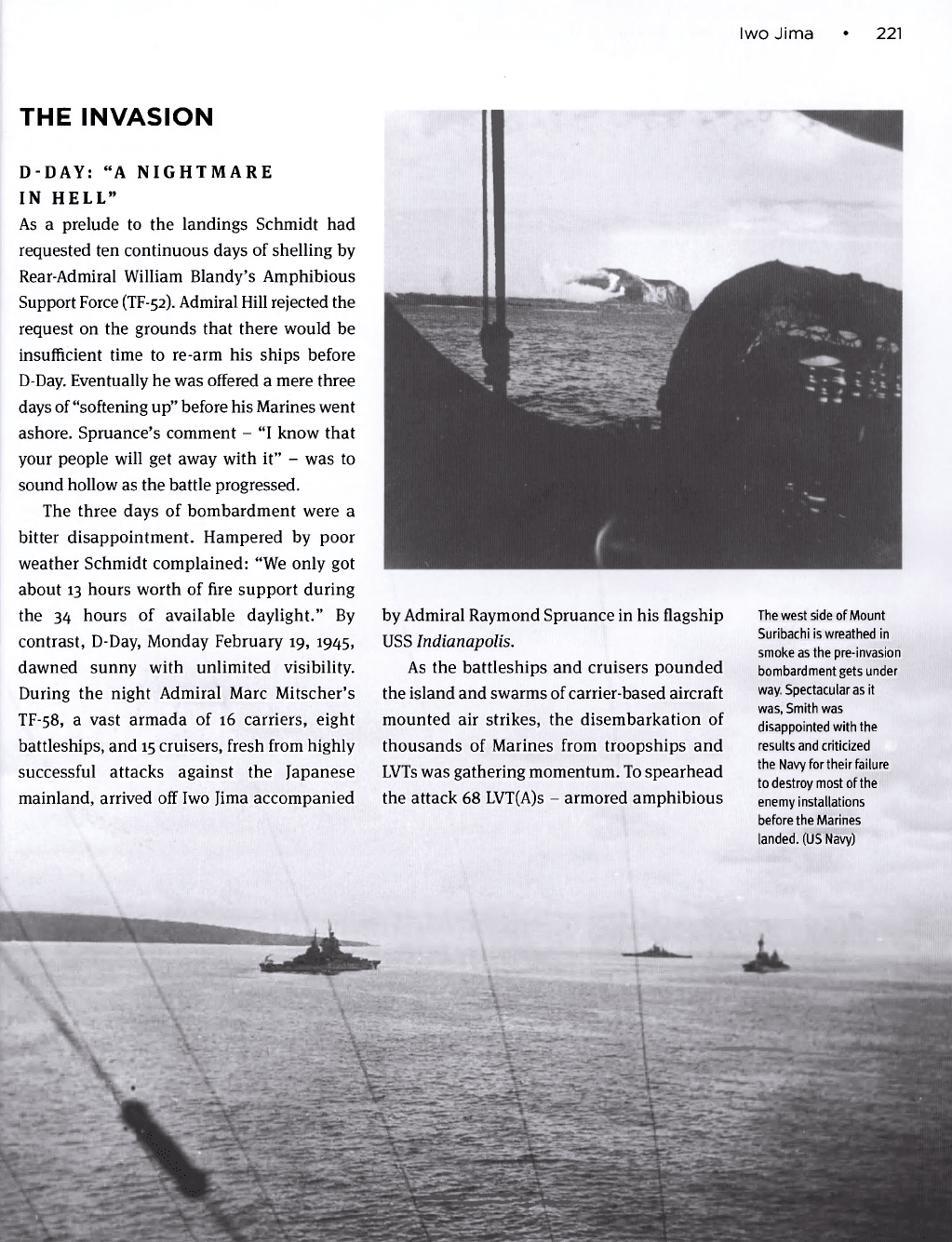
Iwo Jima • 221
THE INVASION
D-DAY: "A NIGHTMARE
IN HELL"
As a prelude to the landings Schmidt had
requested ten continuous days of shelling by
Rear-Admiral William Blandy's Amphibious
Support Force (TF-52). Admiral Hill rejected the
request on the grounds that there would be
insufficient time to re-arm his ships before
D-Day. Eventually he was offered a mere three
days of "softening up" before his Marines went
ashore. Spruance's comment - "I know that
your people will get away with it" - was to
sound hollow as the battle progressed.
The three days of bombardment were a
bitter disappointment. Hampered by poor
weather Schmidt complained: "We only got
about 13 hours worth of fire support during
the 34 hours of available daylight." By
contrast, D-Day, Monday February 19, 1945,
dawned sunny with unlimited visibility.
During the night Admiral Marc Mitscher's
TF-58, a vast armada of 16 carriers, eight
battleships, and 15 cruisers, fresh from highly
successful attacks against the Japanese
mainland, arrived off Iwo Jima accompanied
by Admiral Raymond Spruance in his flagship
USS Indianapolis.
As the battleships and cruisers pounded
the island and swarms of carrier-based aircraft
mounted air strikes, the disembarkation of
thousands of Marines from troopships and
LVTs was gathering momentum. To spearhead
the attack 68 LVT(A)s - armored amphibious
The west side of Mount
Suribachi is wreathed in
smoke as the pre-invasion
bombardment gets under
way. Spectacular as it
was, Smith was
disappointed with the
results and criticized
the Navy for their failure
to destroy most of the
enemy installations
before the Marines
landed. (US Navy)
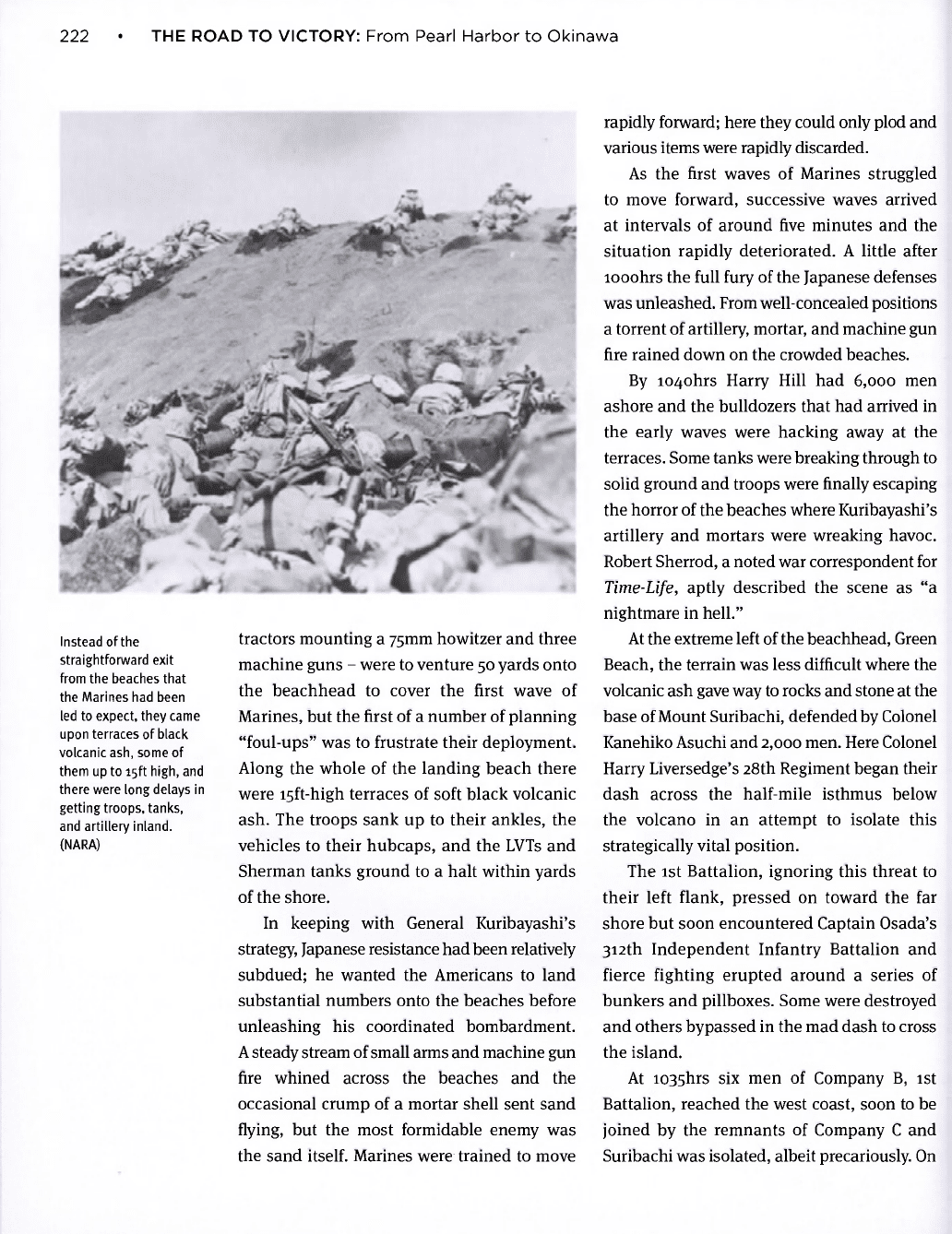
222 • THE ROAD TO VICTORY: From Pearl Harbor to Okinawa
Instead of the
straightforward exit
from the beaches that
the Marines had been
led to expect, they came
upon terraces of black
volcanic ash, some of
them up to 15ft high, and
there were long delays in
getting troops, tanks,
and artillery inland.
(NARA)
tractors mounting a 75mm howitzer and three
machine guns - were to venture 50 yards onto
the beachhead to cover the first wave of
Marines, but the first of a number of planning
"foul-ups" was to frustrate their deployment.
Along the whole of the landing beach there
were isft-high terraces of soft black volcanic
ash. The troops sank up to their ankles, the
vehicles to their hubcaps, and the LVTs and
Sherman tanks ground to a halt within yards
of the shore.
In keeping with General Kuribayashi's
strategy, Japanese resistance had been relatively
subdued; he wanted the Americans to land
substantial numbers onto the beaches before
unleashing his coordinated bombardment.
A steady stream of small arms and machine gun
fire whined across the beaches and the
occasional crump of a mortar shell sent sand
flying, but the most formidable enemy was
the sand itself. Marines were trained to move
rapidly forward; here they could only plod and
various items were rapidly discarded.
As the first waves of Marines struggled
to move forward, successive waves arrived
at intervals of around five minutes and the
situation rapidly deteriorated. A little after
looohrs the full fury of the Japanese defenses
was unleashed. From well-concealed positions
a torrent of artillery, mortar, and machine gun
fire rained down on the crowded beaches.
By io4ohrs Harry Hill had 6,000 men
ashore and the bulldozers that had arrived in
the early waves were hacking away at the
terraces. Some tanks were breaking through to
solid ground and troops were finally escaping
the horror of the beaches where Kuribayashi's
artillery and mortars were wreaking havoc.
Robert Sherrod, a noted war correspondent for
Time-Life, aptly described the scene as "a
nightmare in hell."
At the extreme left of the beachhead, Green
Beach, the terrain was less difficult where the
volcanic ash gave way to rocks and stone at the
base of Mount Suribachi, defended by Colonel
Kanehiko Asuchi and 2,000 men. Here Colonel
Harry Liversedge's 28th Regiment began their
dash across the half-mile isthmus below
the volcano in an attempt to isolate this
strategically vital position.
The 1st Battalion, ignoring this threat to
their left flank, pressed on toward the far
shore but soon encountered Captain Osada's
312th Independent Infantry Battalion and
fierce fighting erupted around a series of
bunkers and pillboxes. Some were destroyed
and others bypassed in the mad dash to cross
the island.
At i035hrs six men of Company B, 1st
Battalion, reached the west coast, soon to be
joined by the remnants of Company C and
Suribachi was isolated, albeit precariously. On
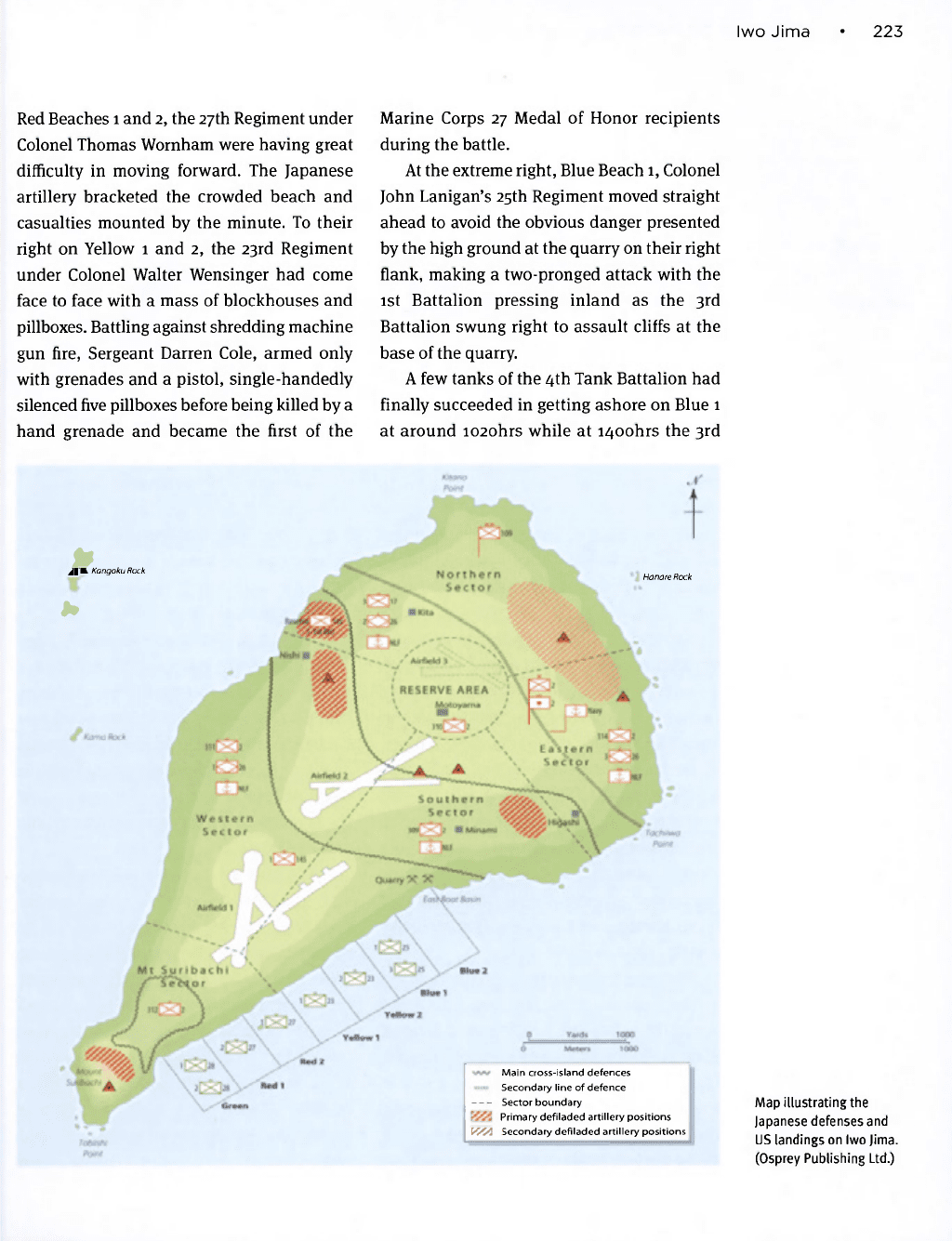
Iwo Jima • 223
Red Beaches 1 and 2, the 27th Regiment under
Colonel Thomas Wornham were having great
difficulty in moving forward. The Japanese
artillery bracketed the crowded beach and
casualties mounted by the minute. To their
right on Yellow 1 and 2, the 23rd Regiment
under Colonel Walter Wensinger had come
face to face with a mass of blockhouses and
pillboxes. Battling against shredding machine
gun fire, Sergeant Darren Cole, armed only
with grenades and a pistol, single-handedly
silenced five pillboxes before being killed by a
hand grenade and became the first of the
Marine Corps 27 Medal of Honor recipients
during the battle.
At the extreme right, Blue Beach 1, Colonel
John Lanigan's 25th Regiment moved straight
ahead to avoid the obvious danger presented
by the high ground at the quarry on their right
flank, making a two-pronged attack with the
1st Battalion pressing inland as the 3rd
Battalion swung right to assault cliffs at the
base of the quarry.
A few tanks of the 4th Tank Battalion had
finally succeeded in getting ashore on Blue 1
at around io2ohrs while at i4oohrs the 3rd
Map illustrating the
Japanese defenses and
US landings on Iwo Jima.
(Osprey Publishing Ltd.)
Main cross-island defences
Secondary line of defence
Sector boundary
Primary defiladed artillery positions
V/XJ Secondary defiladed artillery positions
u
J "
Kangoku Rock
J»
Hanare Rock
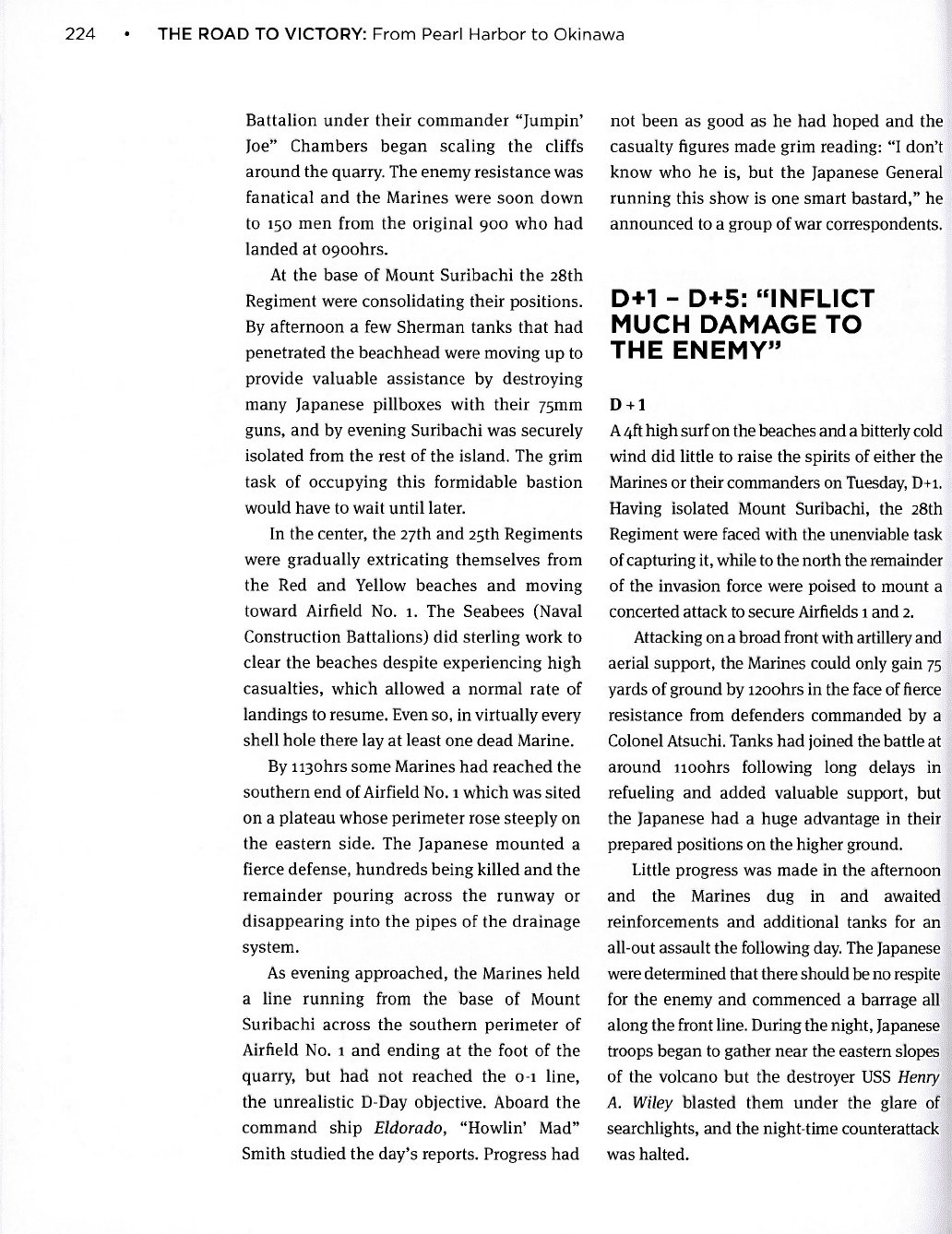
224 • THE ROAD TO VICTORY: From Pearl Harbor to Okinawa
Battalion under their commander "Jumpin'
Joe" Chambers began scaling the cliffs
around the quarry. The enemy resistance was
fanatical and the Marines were soon down
to 150 men from the original 900 who had
landed at ogoohrs.
At the base of Mount Suribachi the 28th
Regiment were consolidating their positions.
By afternoon a few Sherman tanks that had
penetrated the beachhead were moving up to
provide valuable assistance by destroying
many Japanese pillboxes with their 75mm
guns, and by evening Suribachi was securely
isolated from the rest of the island. The grim
task of occupying this formidable bastion
would have to wait until later.
In the center, the 27th and 25th Regiments
were gradually extricating themselves from
the Red and Yellow beaches and moving
toward Airfield No. 1. The Seabees (Naval
Construction Battalions) did sterling work to
clear the beaches despite experiencing high
casualties, which allowed a normal rate of
landings to resume. Even so, in virtually every
shell hole there lay at least one dead Marine.
By ii3ohrs some Marines had reached the
southern end of Airfield No. 1 which was sited
on a plateau whose perimeter rose steeply on
the eastern side. The Japanese mounted a
fierce defense, hundreds being killed and the
remainder pouring across the runway or
disappearing into the pipes of the drainage
system.
As evening approached, the Marines held
a line running from the base of Mount
Suribachi across the southern perimeter of
Airfield No. 1 and ending at the foot of the
quarry, but had not reached the 0-1 line,
the unrealistic D-Day objective. Aboard the
command ship Eldorado, "Howlin' Mad"
Smith studied the day's reports. Progress had
not been as good as he had hoped and the
casualty figures made grim reading: "I don't
know who he is, but the Japanese General
running this show is one smart bastard," he
announced to a group of war correspondents.
D+l - D+5: "INFLICT
MUCH DAMAGE TO
THE ENEMY"
D
+
l
A 4ft high surf on the beaches and a bitterly cold
wind did little to raise the spirits of either the
Marines or their commanders on Tuesday, D+i.
Having isolated Mount Suribachi, the 28th
Regiment were faced with the unenviable task
of capturing it, while to the north the remainder
of the invasion force were poised to mount a
concerted attack to secure Airfields 1 and 2.
Attacking on a broad front with artillery and
aerial support, the Marines could only gain 75
yards of ground by i200hrs in the face of fierce
resistance from defenders commanded by a
Colonel Atsuchi. Tanks had joined the battle at
around lioohrs following long delays in
refueling and added valuable support, but
the Japanese had a huge advantage in their
prepared positions on the higher ground.
Little progress was made in the afternoon
and the Marines dug in and awaited
reinforcements and additional tanks for an
all-out assault the following day. The Japanese
were determined that there should be no respite
for the enemy and commenced a barrage all
along the front line. During the night, Japanese
troops began to gather near the eastern slopes
of the volcano but the destroyer USS Henry
A. Wiley blasted them under the glare of
searchlights, and the night-time counterattack
was halted.
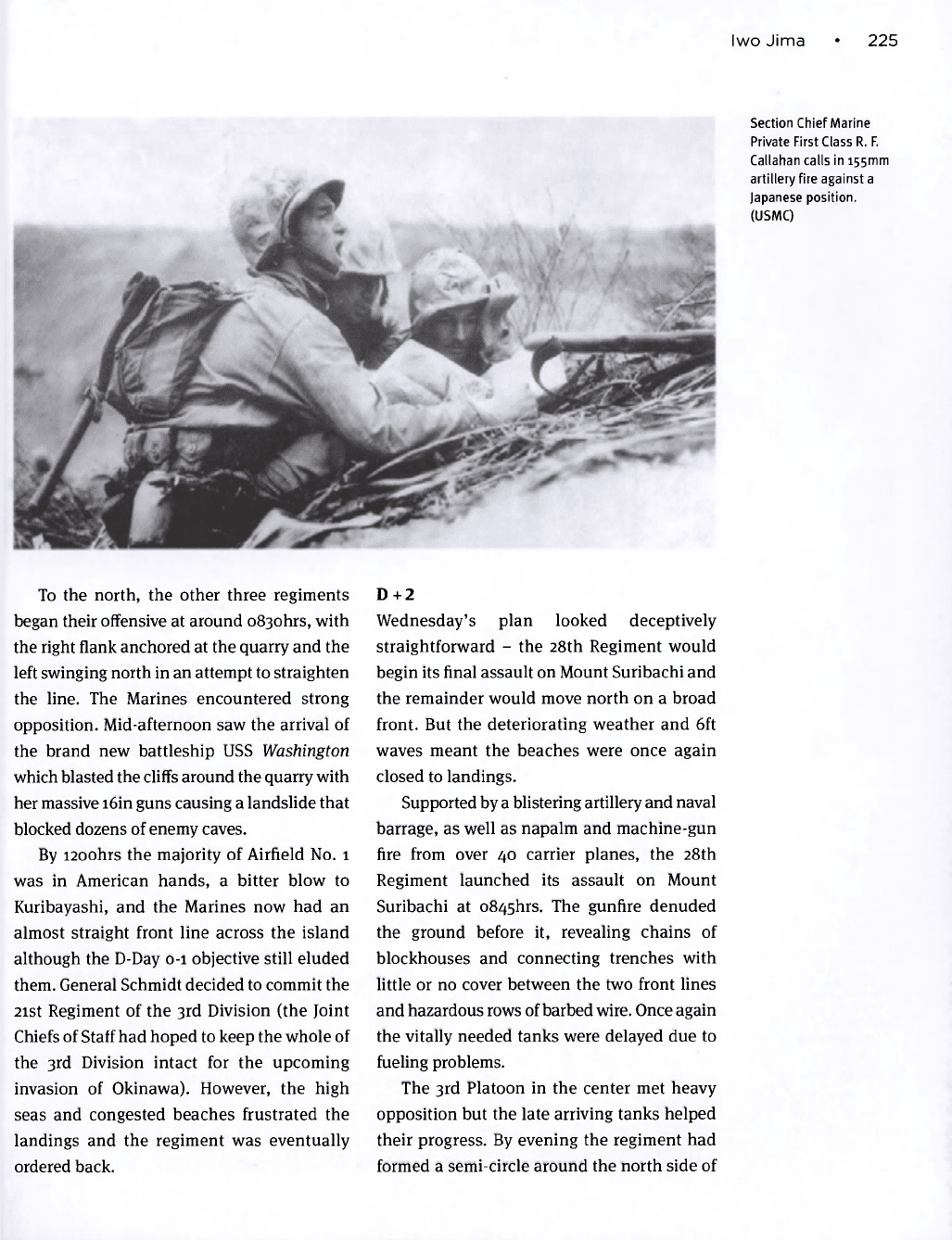
Iwo Jima • 225
To the north, the other three regiments
began their offensive at around o83ohrs, with
the right flank anchored at the quarry and the
left swinging north in an attempt to straighten
the line. The Marines encountered strong
opposition. Mid-afternoon saw the arrival of
the brand new battleship USS Washington
which blasted the
cliffs
around the quarry with
her massive i6in guns causing a landslide that
blocked dozens of enemy caves.
By i2oohrs the majority of Airfield No. 1
was in American hands, a bitter blow to
Kuribayashi, and the Marines now had an
almost straight front line across the island
although the D-Day o-i objective still eluded
them. General Schmidt decided to commit the
21st Regiment of the 3rd Division (the Joint
Chiefs of Staff had hoped to keep the whole of
the 3rd Division intact for the upcoming
invasion of Okinawa). However, the high
seas and congested beaches frustrated the
landings and the regiment was eventually
ordered back.
D+2
Wednesday's plan looked deceptively
straightforward - the 28th Regiment would
begin its final assault on Mount Suribachi and
the remainder would move north on a broad
front. But the deteriorating weather and 6ft
waves meant the beaches were once again
closed to landings.
Supported by a blistering artillery and naval
barrage, as well as napalm and machine-gun
fire from over 40 carrier planes, the 28th
Regiment launched its assault on Mount
Suribachi at oSz^hrs. The gunfire denuded
the ground before it, revealing chains of
blockhouses and connecting trenches with
little or no cover between the two front lines
and hazardous rows of barbed wire. Once again
the vitally needed tanks were delayed due to
fueling problems.
The 3rd Platoon in the center met heavy
opposition but the late arriving tanks helped
their progress. By evening the regiment had
formed a semi-circle around the north side of
Section Chief Marine
Private First Class R. F.
Callahan calls in 155mm
artillery fire against a
Japanese position.
(USMC)
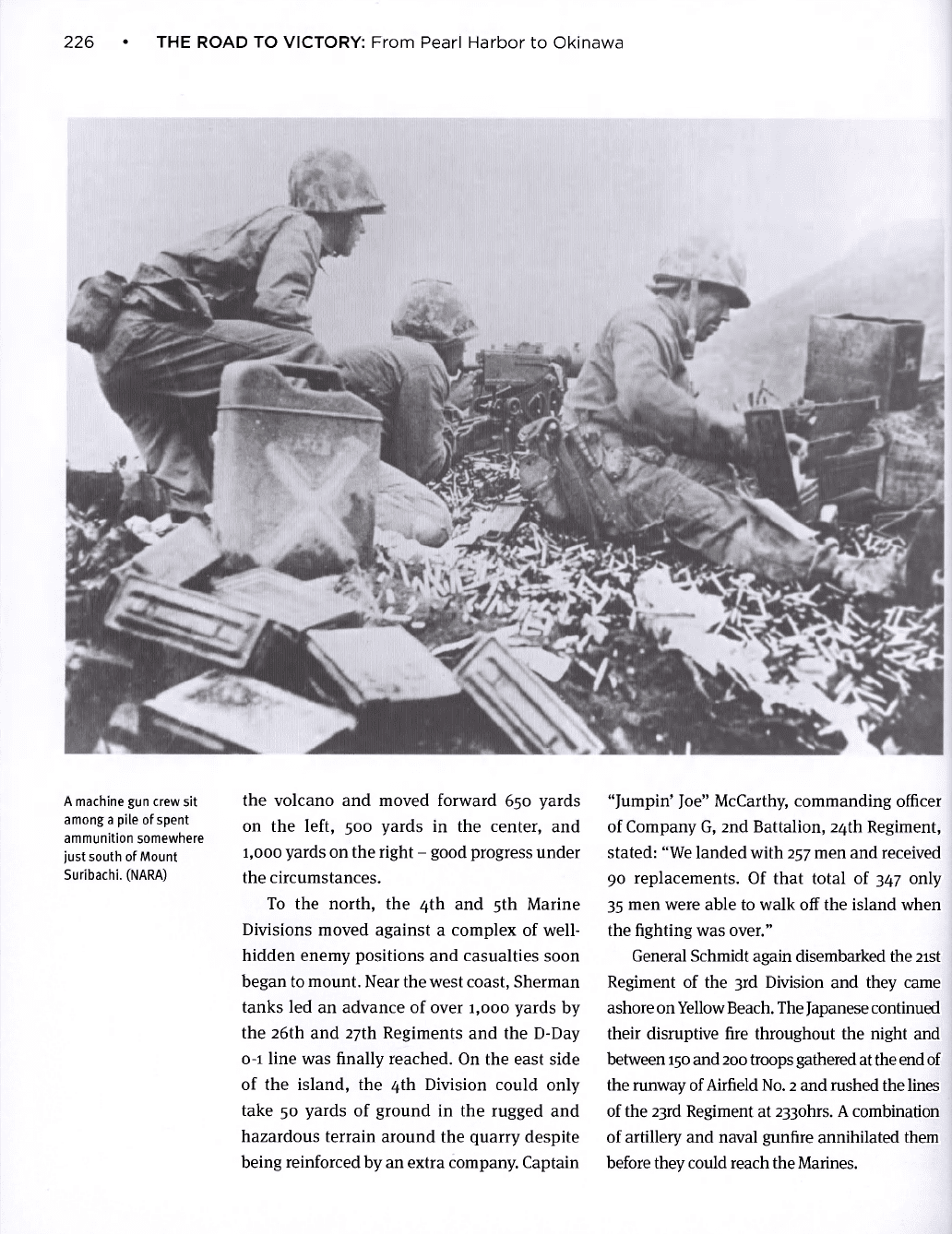
226 • THE ROAD TO VICTORY: From Pearl Harbor to Okinawa
A machine gun crew sit
among a pile of spent
ammunition somewhere
just south of Mount
Suribachi. (NARA)
the volcano and moved forward 650 yards
on the left, 500 yards in the center, and
1,000 yards on the right - good progress under
the circumstances.
To the north, the 4th and 5th Marine
Divisions moved against a complex of well-
hidden enemy positions and casualties soon
began to mount. Near the west coast, Sherman
tanks led an advance of over 1,000 yards by
the 26th and 27th Regiments and the D-Day
0-1 line was finally reached. On the east side
of the island, the 4th Division could only
take 50 yards of ground in the rugged and
hazardous terrain around the quarry despite
being reinforced by an extra company. Captain
"Jumpin' Joe" McCarthy, commanding officer
of Company G, 2nd Battalion, 24th Regiment,
stated: "We landed with 257 men and received
90 replacements. Of that total of 347 only
35 men were able to walk off the island when
the fighting was over."
General Schmidt again disembarked the 21st
Regiment of the 3rd Division and they came
ashore on Yellow Beach. The Japanese continued
their disruptive fire throughout the night and
between 150 and 200 troops gathered at the end
of
the runway of
Airfield
No. 2 and rushed the lines
of the 23rd Regiment at 233ohrs. A combination
of artillery and naval gunfire annihilated them
before they could reach the Marines.
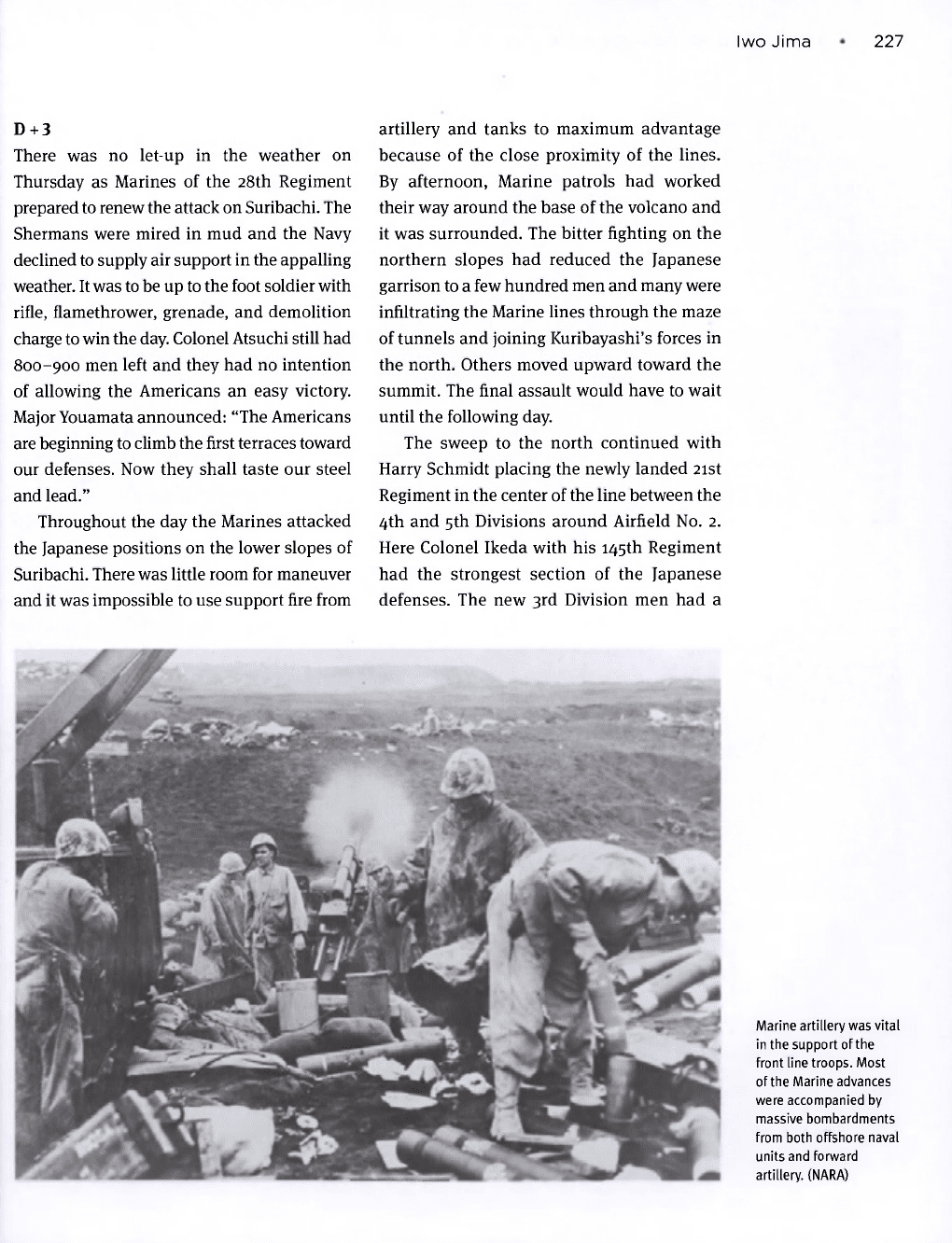
Iwo Jima •
227
Marine artillery was vital
in the support of the
front line troops. Most
of the Marine advances
were accompanied by
massive bombardments
from both offshore naval
units and forward
artillery. (NARA)
artillery and tanks to maximum advantage
because of the close proximity of the lines.
By afternoon, Marine patrols had worked
their way around the base of the volcano and
it was surrounded. The bitter fighting on the
northern slopes had reduced the Japanese
garrison to a few hundred men and many were
infiltrating the Marine lines through the maze
of tunnels and joining Kuribayashi's forces in
the north. Others moved upward toward the
summit. The final assault would have to wait
until the following day.
The sweep to the north continued with
Harry Schmidt placing the newly landed 21st
Regiment in the center of the line between the
4th and 5th Divisions around Airfield No. 2.
Here Colonel Ikeda with his 145th Regiment
had the strongest section of the Japanese
defenses. The new 3rd Division men had a
D+3
There was no let-up in the weather on
Thursday as Marines of the 28th Regiment
prepared to renew the attack on Suribachi. The
Shermans were mired in mud and the Navy
declined to supply air support in the appalling
weather. It was to be up to the foot soldier with
rifle, flamethrower, grenade, and demolition
charge to win the day. Colonel Atsuchi still had
800-900 men left and they had no intention
of allowing the Americans an easy victory.
Major Youamata announced: "The Americans
are beginning to climb the first terraces toward
our defenses. Now they shall taste our steel
and lead."
Throughout the day the Marines attacked
the Japanese positions on the lower slopes of
Suribachi. There was little room for maneuver
and it was impossible to use support fire from
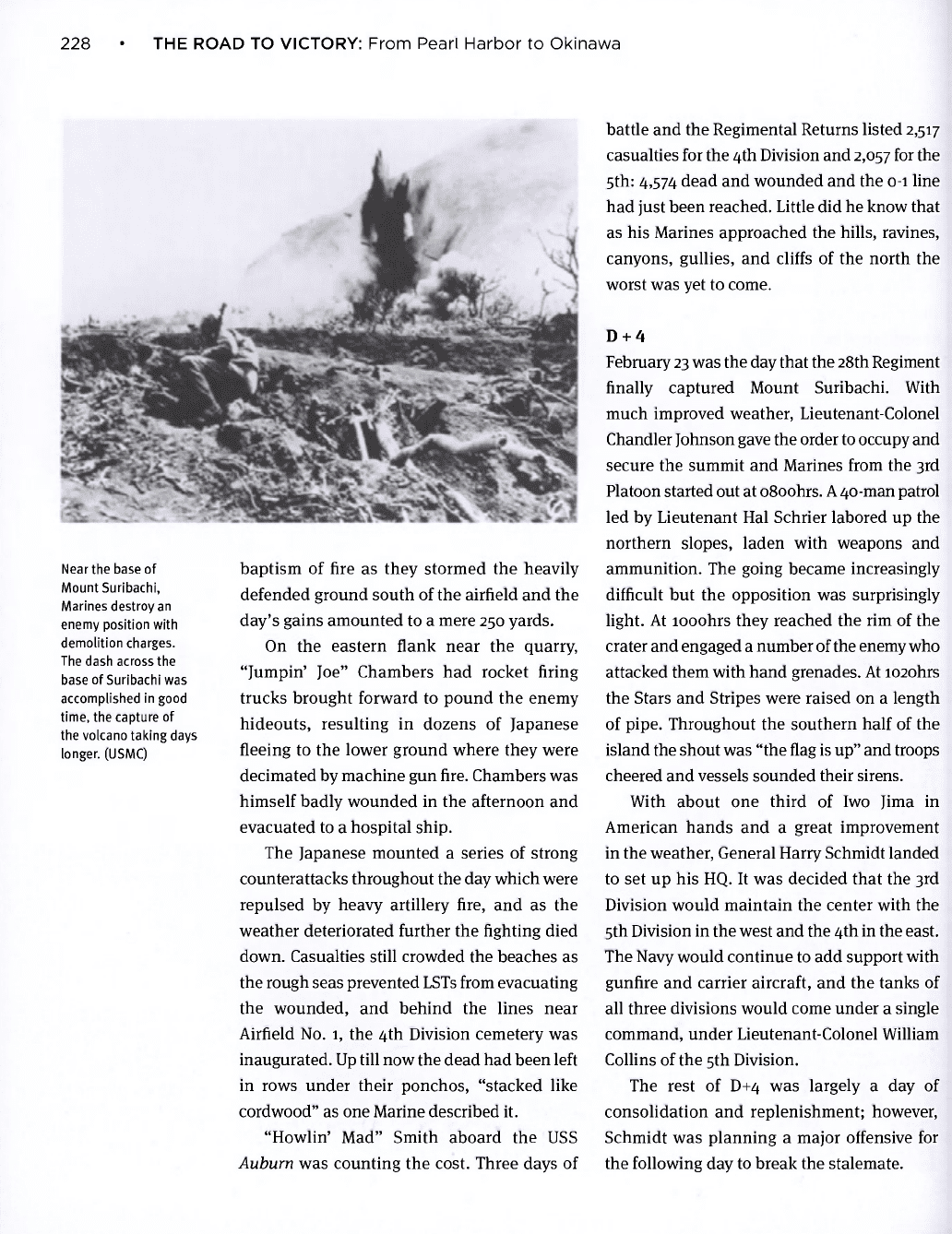
228 • THE ROAD TO VICTORY: From Pearl Harbor to Okinawa
Near the base of
Mount Suribachi,
Marines destroy an
enemy position with
demolition charges.
The dash across the
base of Suribachi was
accomplished in good
time, the capture of
the volcano taking days
longer. (USMC)
baptism of fire as they stormed the heavily
defended ground south of the airfield and the
day's gains amounted to a mere 250 yards.
On the eastern flank near the quarry,
"Jumpin' Joe" Chambers had rocket firing
trucks brought forward to pound the enemy
hideouts, resulting in dozens of Japanese
fleeing to the lower ground where they were
decimated by machine gun fire. Chambers was
himself badly wounded in the afternoon and
evacuated to a hospital ship.
The Japanese mounted a series of strong
counterattacks throughout the day which were
repulsed by heavy artillery fire, and as the
weather deteriorated further the fighting died
down. Casualties still crowded the beaches as
the rough seas prevented LSTs from evacuating
the wounded, and behind the lines near
Airfield No. 1, the 4th Division cemetery was
inaugurated. Up till now the dead had been left
in rows under their ponchos, "stacked like
cordwood" as one Marine described it.
"Howlin' Mad" Smith aboard the USS
Auburn was counting the cost. Three days of
battle and the Regimental Returns listed 2,517
casualties for the 4th Division and 2,057 for the
5th: 4,574 dead and wounded and the 0-1 line
had just been reached. Little did he know that
as his Marines approached the hills, ravines,
canyons, gullies, and cliffs of the north the
worst was yet to come.
D
+
4
February 23 was the day that the 28th Regiment
finally captured Mount Suribachi. With
much improved weather, Lieutenant-Colonel
Chandler Johnson gave the order to occupy and
secure the summit and Marines from the 3rd
Platoon started out at o8oohrs. A 40-man patrol
led by Lieutenant Hal Schrier labored up the
northern slopes, laden with weapons and
ammunition. The going became increasingly
difficult but the opposition was surprisingly
light. At looohrs they reached the rim of the
crater and engaged a number of the enemy who
attacked them with hand grenades. At io2ohrs
the Stars and Stripes were raised on a length
of pipe. Throughout the southern half of the
island the shout was "the flag is up" and troops
cheered and vessels sounded their sirens.
With about one third of Iwo Jima in
American hands and a great improvement
in the weather, General Harry Schmidt landed
to set up his HQ. It was decided that the 3rd
Division would maintain the center with the
5th Division in the west and the 4th in the east.
The Navy would continue to add support with
gunfire and carrier aircraft, and the tanks of
all three divisions would come under a single
command, under Lieutenant-Colonel William
Collins of the 5th Division.
The rest of D+4 was largely a day of
consolidation and replenishment; however,
Schmidt was planning a major offensive for
the following day to break the stalemate.
